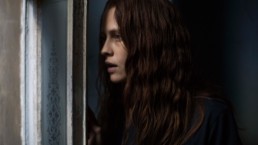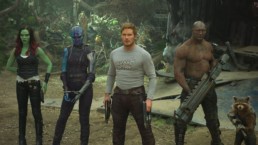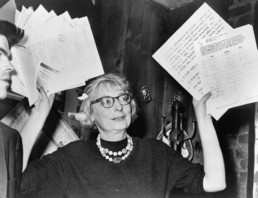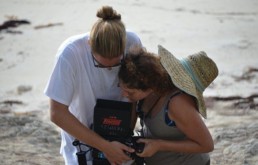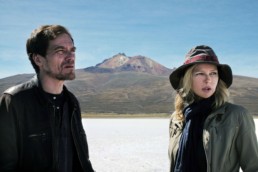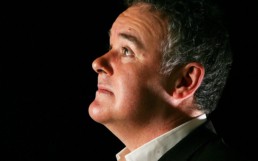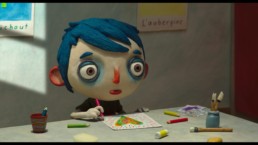'Berlin Syndrome' Review: An Unsettling White-Knuckle Thrill Ride
This review previously ran on January 22, 2017, during the Sundance Film Festival
The premiere of Cate Shortland’s new film, unfortunately, may have been overshadowed by two major faux pas and technical errors that occurred during the screening.
And while some who attended may choose to make those accidental errors the headline, this film is more than worthy of talking about beyond that unwanted attention.
Berlin Syndrome is the story of an Australian backpacker Clare (Teresa Palmer) who finds her way into a one night stand with a savvy local German named Andi (Max Riemelt) that ultimately turns into a possessive, dangerous relationship she isn’t able to walk away from. It’s a tense, painful journey as Clare becomes completely trapped in this dysfunctional relationship. For the majority of the duration, we watch as she grapples with attempts at escape and also an insidious acceptance of the grim, sickening fate that she may have found herself in.
The title, presumably, is a play on the colloquialism ‘Stockholm Syndrome’ in which we too find ourselves in Clare’s situation over the course of the film– equally unable to break out of her circumstances. The resulting story becomes a visceral and emotionally thought-provoking thrill ride from start to finish.
On top of being a thriller that’s impossible to not get engrossed in (and wishing for an escape the entire time), the story manages to work in some greater subtext...
On top of being a thriller that’s impossible to not get engrossed in (and wishing for an escape the entire time), the story manages to work in some greater subtext that I hope to explore further as the film finds release: the city of Berlin is a defining character here, representing a city with a totalitarian past. Another detail (thanks to the brief Q&A) is that Berlin is a city filled with young men who were abandoned by their mothers. These layers establish themselves as directly building on the movie’s setting. This ends up refining the film not only as a late-night thriller but also a nuanced, complex look at a tumultuous city in the wake of a divided past. Within this, Andi’s apartment, the pivotal location, also serves as a continual metaphor for both the city’s history and what the character goes through in this story. These elements make this a film immediately worthy of revisiting as it has time to reach the cultural zeitgeist.
For combining a white-knuckle mental thrill ride with more profound undertones, Berlin Syndrome stands out as an early film to watch from Sundance 2017. The film was pre-bought by Netflix, so anticipate this film as one to watch this coming year.
'Berlin Syndrome' is rated R for disturbing violent content, strong sexuality, nudity and some language. 116 minutes. Now playing at ArcLight Hollywood and on VOD.
'Guardians of the Galaxy Vol. 2' Review: A Fresh Take on a Familiar Storyline
Despite all of these different subsets of films within the Marvel Universe, Guardians of the Galaxy is arguably able to distance itself as the one that has cultivated its own identity.
We are nearing the 10th anniversary as well as the rumored end of Robert Downey Jr.’s breakout role in Iron Man, and the aftermath has proven that there are essentially two types of people: those who are going to see every Marvel feature no matter what, and those who lost interest sometime during the past 14 movies (with 8 more scheduled over the next 3 years). Indeed, with so many sequels, characters, and connecting storylines, it now seems so long ago when The Avengers (2012) was one of my favorite films of the year. Yet at this point, like a multi-season TV show, I’m far enough into the Marvel Universe that I plan to stick it out until the ‘finale’ scheduled for 2019.
Despite all of these different subsets of films, Guardians of the Galaxy is arguably able to distance itself as the one that has cultivated its own identity. Playing more like a superhero version of Star Wars, Guardians spins separately from the Avengers characters by making their own rules while still under the Marvel umbrella.
Guardians of the Galaxy Vol. 2 catches us up to speed with all the characters we met in the original. If you liked Vol. 1, you will certainly like this one: it’s a comforting return to form with all the signatures: zany aliens, jabbing banter, and a great soundtrack. But I’m happy to say that unlike other Marvel sequels, which retread their characters entirely, writer-director James Gunn has found interesting ways to develop each character a bit further. There’s a great rivalry between the heroic Gamora (Zoe Saldana) and her mostly villainous sister Nebula (Karen Gillan) that is more at the center of this film than the previous one. Drax (Dave Bautista), a standout from the first film, continues his same brand of humor but with a little more self-awareness. And Baby Groot (Vin Diesel) is impossible not to love. It’s impressive that within this ensemble, each actor brings a freshness to the role while developing their respective character.
...Unlike other Marvel sequels, which retread their characters entirely, writer-director James Gunn has found interesting ways to develop each character a bit further.
Another praiseworthy note is that this universe has a great sense of color. Every alien comes in a variety of bright yellow, blue, and other eye-catching hues, making for a stunning visual much richer than a comparable action/adventure movie. The CGI is present but there are plenty of characters in full make-up and practicals rather than being entirely artificial, and this combination works seamlessly here.
While I was annoyed that the trailer announced Kurt Russell as being Star-Lord aka Peter Quill's (Chris Pratt) father, Emperor J'son (a fact that seemed like a spoiler), it actually proved more enticing, taking the audience on the journey of their new relationship as a father and son. Like the rest of the ensemble cast, Star-Lord and J’son are given challenges that enhance and further develop their characters. As formulaic and familiar as it all may seem, Guardians of the Galaxy Vol. 2 is fresh enough for those invested in the Marvel universe. After seeing this installment, I am eagerly anticipating the next time these characters mesh with The Avengers on the big screen.
Guardians of the Galaxy Vol. 2 is rated PG-13. 121 minutes. Opening this Friday in theaters everywhere.
'Citizen Jane: Battle for the City' Review: Celebrating an Urban Visionary
As I write all this, I realize I’m hardly even reviewing the movie, but sharing some of the insight and revelation I’ve gained by watching it.
A primary purpose of nonfiction filmmaking is rooted in education and a deeper understanding of a topic. So while film aficionados are often looking for boundary-pushing methods and devices to tell these stories, there is something inherently important about the simple matter of using documentary as a tool of education. And a documentary like Citizen Jane: Battle for the City is an education that we all could stand to gain from.
The ultimate shake-up experienced by watching Citizen Jane is that the design of the cities we inhabit does not have to be this way. Many cities are constructed and planned so poorly for the masses, or done in a way to make a handful of people wealthy. Two examples I accept as "must-haves" for cities are: busy/wide avenues for cars and massive high rises. These are both concepts designed to inflate the wealth of the auto and construction industries and result in a massive degradation of public spaces and the essential human interaction that comes from it. And not every city depends on either to grow large and create inhabitable spaces.
This historical doc hones in on a period post-WWII when modernism was all the rage and a handful of elites were attempting to draw the city of the future, which turned out to be a design that looked nice from the top down but had no bearing on what the people inhabiting it would actually find useful. In opposition, an individual named Jane Jacobs called out how disastrous these ideas were. Jane Jacobs was a person of the people: she lived in a city, she took the time to see how it operated. Her famous book The Death and Life of the Great American Cities was a carefully researched look at how cities operate as living organisms and ecosystems that grew character and functionality from the bottom-up, rather than some master plan. These are concepts I have never fully understood and had accepted the way cities are designed as a standard when in fact they are counter to these arguments. Alas, my sister, who is a published graduate student in geography studies, undoubtedly has been aware of Jane Jacobs’ philosophies for years at this point. Seeing everything laid out here is an education I had yet to experience, and I imagine is true of most city dwellers.
Her famous book The Death and Life of the Great American Cities was a carefully researched look at how cities operate as living organisms and ecosystems that grew character and functionality from the bottom-up, rather than some master plan.
The film follows a few of the battles Jane waged against urban tycoon Robert Moses, who attempted to eradicate affordable housing and public community spaces in favor of massive high-rise projects and vast highways. Today, cities (especially Los Angeles) are so car-dependent it’s hard for us to imagine a design where they aren’t needed. The most well-functioning cities are not. Through a series of expert interviews and archival images, we get a sense of the formation of many cities that were designed to be modern, yet most of which ended up being failures and becoming dilapidated. It’s inspiring to see what people can do to oppose terrible legislation decisions, and I only wish that I personally knew how to stand up as an activist in the tangible way Jane Jacobs did. Despite seeing some of her successes, this film is by no means a how-to.
As I write all this, I realize I’m hardly even reviewing the movie, but sharing some of the insight and revelation I’ve gained by watching it. There is much to be learned from watching this film and it will leave a profound look at how cities function and operate, something we all can benefit from. In my hometown of Denver, Colorado, mayor Michael Hancock has been notorious for approving so-called ‘modern’ high rises. Like Robert Moses in this film, there is much money to be made. And yet after seeing this movie, there is evidence that suggests how detrimental these are toward the community and the vitality that makes a city feel inhabited. It’s a straightforward think piece, but one that feels extremely beneficial to have walked away from, and for that alone, I implore all fellow urbanites to check out the education of Citizen Jane.
'Citizen Jane: Battle for the City' is not rated. 92 minutes. Now playing at the Nuart Theatre.
Director Logan Sandler and DP Daniella Nowitz on Colorless Paradise in 'Live Cargo'
We've been quoted as saying "Live Cargo" is "An unforgettable filmmaking debut," and after talking to director Logan Sandler and cinematographer Daniella Nowitz, we even further emphasize that statement. In our exclusive interview, which took place the day before the film's Los Angeles release (now playing at Arena Cinelounge Sunset), Sandler and Nowitz talk about the beginning of their creative relationship at AFI Film School, their disregard in following the traditional "classic" film structure, and the decision to shoot the picturesque island of Bimini in black and white.
The film has such a distinct visual style, and I'm always interested in the director/DP relationship. Have you two worked together before?
Logan Sandler: Yeah, we did our AFI thesis film together called "Tracks." How AFI works is you collaborate with your crew for about a year prior to shooting, so Daniella and I already had a visual style and vocabulary already established prior to us making "Live Cargo."
Daniella Nowitz: I remember being so impressed by Logan at AFI because I worked on one of his sets in my first year and we had this entire conversation about [Michelangelo] Antonioni. None of the other directors really cared who Antonioni was, and the school is so focused on American cinema, so it was really exciting to meet someone who also liked European cinema.
What was the leap like going from a short film to a feature film?
LS: There are so many other things at play when making a feature. Having Daniella onboard made that initial process of bringing the script to visual light was familiar.
DN: In the short, we got to experiment visually, and a lot of those things we took to the next level in the feature. Mostly, the long handheld moves that track with the character and not cutting away a lot. We also got to shoot with the same actor, Lakeith Stanfield, which was really helpful because I already knew how he would photograph and move.
"We ended up turning efficiency into a creative strength." -Logan Sandler

It sounds like you had a great director/DP/actor dynamic. How did the three of you work together?
LS: My process with Lakeith is very organic and intuitive. We've established a sense of trust between actor, director, and camera. He was very in tune to understanding how we worked and what we wanted from him.
DN: Knowing that Logan wanted these long, flowing handheld shots, I was able to bring on my camera operator, Julián Estrada, who also worked on the short. I am 5 feet tall... haha. I can operate handheld but when you have to do long tracking shots of people who are taller, I need to work with an operator. Julián is amazing, he also collaborated with us and was ready to do the craziest, longest shots.
Was the script ready when you signed on?
DN: There was a script, and I told Logan it was one of the most beautiful things I have ever read and I have to shoot this movie. I think we had first imagined "Live Cargo" as a more "classic" film with "classic" structure, but when we got to the Bahamas, the place took over the story. In the best possible way! It really dictated so many of our decisions, including the black and white look and non-traditional narrative structure. That structure is one of my favorite things about the movie because I think it really reflects the experience of being on this island, the way life flows over you- like the waves of the ocean.
LS: Yeah, it wasn't necessarily possible to bring a dolly or other instruments we use to achieve certain cinematic moments. In order to achieve the authenticity of the location, we chose to use a handheld camera for a lot of the shoot because it opened us up to capturing the characters in their true self. It allowed them to roam freely without weighing them down.
DN: On a lighting level, we kept it very simplistic. We wanted the authenticity of the place, we didn't want to light this like a Hollywood movie. Whenever we could shoot without lights, like in a bar or in a club, we would shoot without lights. And it's not like we had a truck with a lift gate, we were on this island that has one main road that's very narrow at parts and not paved. There was no way we could ride around with [a ton of gear].
LS: We ended up turning efficiency into a creative strength.
I loved the decision to shoot in black and white, that's what made "Live Cargo" leave a lasting imprint in my mind.
LS: To be frank, one of the reasons why we chose to shoot in black and white, outside of our thematic, metaphorical, and other artistic reasons, was because after looking at our test stills with our collaborators, many times people would walk away from the images and the first thing they would remember was how blue the water was. That's not something we wanted to portray in the film. So there was confidence in the freshness and originality of approaching it in black and white.
DN: I still remember the moment Logan brought up the black and white idea. We had gone down to the Bahamas to location scout and shoot some test footage, and after watching the footage back, something felt off. I remember we were having a beer at the end of the day and Logan just said, "What if we just shot this movie in black and white?" As a cinematographer, my first reaction was like, "That's crazy! Look at where we're at, look at these colors!" After I thought about it for a minute, I knew that was it.
"...Logan just said, "What if we just shot this movie in black and white?" As a cinematographer, my first reaction was like, "That's crazy! Look at where we're at, look at these colors!'" -Daniella Nowitz

Is there anything you want audiences to know about the culture in the Bahamas?
DN: I've shot in almost 30 countries and I'm very used to going into a culture and absorbing it. What was different for me [in the Bahamas] was the feeling of the place, the feeling of island life. Everybody knows each other. The day we left the island, people were crying because they were so sad to see us go. We became a part of the fabric of this island. For me, the real experience here is going to a tiny place and becoming a part of it.
LS: Yeah, everybody in the crew put away their laptops... no one was on Facebook or Twitter or Instagram because the atmosphere there opens up to a lot more self-reflection. Myself, the actors, the crew- there was a lot more self-reflection during the shoot even though we were busy as shit. I think everyone grew, and became a better person in a way, once we left the island because of that.
After wrapping up the shoot for a day, how would you prepare for the next day?
LS: Oh it was crazy, insane. I'm not gonna lie, it was like out of one of Werner Herzog's crazier documentaries. There were a lot of issues with closing down locations and confirming locations for the next day. There were countless times when Daniella and I had scouted and confirmed a location, and about 50% of the time, once we got there [to shoot], the owners of the location wouldn't answer! So as far as planning for the next day of shooting, we always had to have a backup plan, and a lot of times, multiple backup plans.
DN: And because of that, we had to be ready to shoot any part of the movie at any given moment. It wasn't like a regular shoot where you know what scenes you're shooting in week one. We tried to do that as much as possible but we had to be flexible with the island. But for as hard as it was in the moment, in retrospect, some of the most beautiful moments in the film came out of those scenarios. Like the scene where Dree Hemingway is dancing in the club; we had a different location planned but we just came across that place and it was perfect. We literally just asked if we could come in and shoot and we shot the scene in about an hour.
"So there was confidence in the freshness and originality of approaching it in black and white." -Logan Sandler

Has anyone from the island been able to see the film?
LS: The local audience that has seen the film has received it very well. We screened at the Bahama Film Festival and won the top award there. What really blew me away was the night of our Tribeca premiere: Two of our locations were provided by the same family and they had been tracking the film since we left. On their own, they bought tickets to New York City, got a hotel, and were waiting at the film's premiere at the Tribeca Film Festival. They bought tickets and everything, they wanted to see it! It was definitely a film made by a community, I can say that.
Do you have any advice, specific to your roles as director and DP, for those working in independent film?
DN: The most important thing, in the same vein of what we've been talking about, is being flexible. Also, understand the importance of the collaboration process you're a part of. And having a good time! As hard as the shoot was, what made the actors and crew enjoy themselves and the locals happy to have us is that we all did this shoot with so much love. It sounds like a cliche but it's really true.
LS: That's well said! I would echo those same sentiments. The only way to get an indie film done is with your team. There will be a lot of trials and tribulations along the way and it's not going to be easy, but if you're determined enough to make it happen and believe in your heart that what you're doing is really what you should be doing, then the sky's the limit.
'Salt and Fire' Review: Werner Herzog's Latest is Bizarre. Very Bizarre.
Whatever plot exists in the film is essentially is a veil for a handful of characters to speak in Herzog-ian dialogue.
Midway through Salt and Fire, a character who has been in a wheelchair for the entire film suddenly stands up and starts walking around. Laura (Veronica Ferres), our protagonist, says to him:
“Dr. Krauss. I see you walking. Is this a miracle?”
“No. I only use the wheelchair when I'm tired of life”
This is a taste of the bizarre dialogue from Salt and Fire. In addition to being nonsensical, it’s given such a wooden delivery it actually feels like a movie dubbed by someone who doesn't speak English. It's so bizarre, it had me wondering how aware the filmmaker was of the film's delivery– if this were a first-time filmmaker I would assume they had absolutely no idea what they're doing.
However, this is a film made by acclaimed filmmaker Werner Herzog, who just last year directed two top-tier, intellectually challenging documentaries. His career is full of artfully crafted (although certainly eccentric) works of cinema.
Yet with his latest outing, Salt and Fire, the further I watched, the more I began to theorize a most unusual thought: is Werner Herzog trolling us right now? Knowing what he is capable of and his recent work, it seems hard to imagine that he can watch this film back and say it’s great filmmaking.
Whatever plot exists in the film is essentially is a veil for a handful of characters to speak in Herzog-ian dialogue. In recent years, Herzog’s eccentric persona has become a bit of a caricature that he himself has embraced, because as he has said, saying big words with his Bavarian accent is a recipe for intrigue.
It’s even more bizarre when talented actors like Michael Shannon and Gael Garcia Bernal, who we’ve seen deliver powerhouse performances elsewhere, speak using Herzog vocabulary but in a robotic and nonsensical matter.
It’s even more bizarre when talented actors like Michael Shannon and Gael Garcia Bernal, who we’ve seen deliver powerhouse performances elsewhere, speak using Herzog vocabulary but in a robotic and nonsensical matter. One of the main characters, Dr. Krauss, is not played by an actor, but by an actual scientist, and his delivery is painfully bad but sounds normal because everyone else in this universe is speaking in such an unnatural manner.
Other clues suggest some sort of self-aware tomfoolery at foot. In one shot that takes place on an airplane, Herzog makes a director’s cameo sitting behind the characters on the flight. It becomes comical as the scene runs, in a single take, for well over 5 minutes with Herzog looming the background the entire time.
However, the moment that most assured me this must be trolling is when Michael Shannon, midway through a conversation about the earth and nature, breaks the fourth wall, looking directly at the camera and says the movie’s title. Salt and Fire. Any self-seriousness is gone with a moment like that.
Regardless of if Herzog is intentionally trolling us or not, the movie is frankly unwatchable. Thankfully it’s only 98 minutes, but this is the type of bad cinema that could make a casual moviegoer never want to enter their local indie movie theater again. Maybe, one day this film will be rediscovered as Herzog’s misunderstood commentary on the self-seriousness of the world. But more likely, it’s destined to live at the bottom of the 99-cent bargain bin section… amidst other pieces of salt… and fire…
'Salt and Fire' is not rated. 98 minutes. Opening at the today the Arena Cinelounge Sunset and on VOD.
'Live Cargo' Review: This Island Retreat is Anything but Paradise
This film was reviewed as first seen at this year's AFI FEST presented by Audi.
It’s nearly impossible to think of a movie off-hand that is set in the Bahamas, even more difficult to think of one that’s a drama, but it’s almost assured that there has never been a film set in the Bahamas (or dare I say anywhere in the Caribbean) that is filmed entirely in black and white. And here we have our first entry in "Live Cargo."
While the tropics are a lushly beautiful place with brightly colored postcard-worthy scenery, in this film we see the islands through the eyes of a young couple grieving a tragedy, and therefore, the palette is reduced to stark black and white. The complete removal of color perfectly sets the tone for the absence of life they’re experiencing and allows us to focus on the core messages instead of ogle at the scenery.
Indeed, one of the strengths of "Live Cargo" is that it allows the imagery to do most of the work rather than relying on dialogue. The setting feels like a dynamic world which people inhabit rather than just a pretty backdrop. It also helps that the protagonist couple, Nadine and Lewis (Dree Hemingway and Keith Stanfield), are visitors to the island and find themselves side characters in a plot revolving around a power struggle between rival patriarchs of the island. Rather than 90 minutes of a couple grieving alone, we experience them within the fabric of numerous other compelling characters, each of whom plays a pivotal role.
"Live Cargo" is an unforgettable debut and a promise of greater heights to come.
At times the emphasis on the mood and setting cause the plot to feel like it's on the backburner, and yet the imagery is so strong that I vividly remember entire moments from the film even after a week of film-hopping at AFI. Nothing feels inauthentic to the characters or location and, for the most part, the plot devices fall naturally into order rather than being forced for sake of melodrama.
This is the first feature for both director Logan Sandler and DP Daniella Nowitz, and they’ve both cast their mark in capturing mood and setting. "Live Cargo" is an unforgettable debut and a promise of greater heights to come.
'Live Cargo' is not rated. 88 minutes. Opening at the Arena Cinelounge Hollywood on Friday, 4/7.
Political documentarian Adam Curtis will change the way you see the world
Legendary political filmmaker you may not know, Adam Curtis, stands to benefit from the age of streaming.
Last weekend, LA’s famous Cinefamily hosted British documentarian Adam Curtis as a guest curator. Using his latest film, "HyperNormalisation," as a thematic guide, Curtis selected a handful of older films that are relevant today, including "Blow Out," "Super Troopers," and "The Passenger." This article is a response to last weekend's event and Curtis’s understated place in the documentary landscape.
It’s worth asking what the scope of documentaries really is, and if they’re able to reach an audience broad enough to make an impact they share their information with. Certainly, "Blackfish" is the crown jewel of a documentary that had a tangible effect, to the point where conglomerate SeaWorld now addresses their mistakes in their commercials as a way to cling onto any good will. This is the outlier rather than the norm for nonfiction filmmaking.
However, for all the disruption that a streaming era of cinema has brought upon a neophobic industry, it has opened the doors for documentaries to reach wider audiences than ever before. This is potential for master documentarians to gain followings that would’ve never otherwise been exposed to their work. Ava Duvernay’s “13th,” produced by Netflix, stands out as a beacon of hope for educational, widespread documentaries to reach massive audiences. Ezra Edelman’s Oscar-winning documentary “OJ: Made in America” is proof that the restraints of yesteryear, notably the seven-hour runtime, are slowly being shed from the table so long as the material demands it (and that one most certainly does). There is room for many more films at this table.
One veteran documentarian who has seen an uptick in the advent of streaming is BBC filmmaker Adam Curtis. In the last 2 years, he has released two documentaries to the British streaming site BBC iPlayer: "Bitter Lake" in 2015 and "HyperNormalisation" in 2016. Prior to these films, Curtis made a vast number of educational BBC mini-series projects, which show him delving into long-form documentary. I discovered Curtis thanks to the film-heaven-on-earth known as Telluride Film Festival, where in 2015 he was an honoree in conjunction with "Bitter Lake." It was there where I saw, without knowing what to expect, the power of his cinema.
It was there where I saw, without knowing what to expect, the power of his cinema.
"Bitter Lake" begins in the midst of World War II, with a meeting between two world leaders, U.S. President Franklin Roosevelt and King Abdulaziz of Saudi Arabia, at Bitter Lake, near the Suez Canal in Egypt. Over the course of a few days, these two leaders, despite massive cultural differences, made an agreement regarding Saudi Arabia’s oil that would shape world politics for the rest of history thus far. This meeting can’t be found in any textbook but it is well documented online. By titling his film after this, and using it as a starting point, Curtis frames the beginning of a history we may know pieces of but have never seen so comprehensively laid out. What follows is a thorough education on the United States' involvement in the Middle East and continual hunger for power and resources. Using a wide swath of archival material previously never seen before, Curtis paints a history lesson that won’t be found in any textbooks yet gives a much more honest explanation for many of the world events we’ve witnessed in the last 70 years. He brings us all the way up to present day from that fateful meeting at Bitter Lake, and by then you may feel drenched in information but will leave with a much richer understanding of what decisions have led us to where we are. It’s an education that once heard, is impossible to forget.
Last fall, Curtis released his follow-up feature documentary, "HyperNormalisation." Even more ambitious in its approach, from 1975 to present day, Curtis covers a scatter plot of topics including artificial intelligence, the internet, news & media, Syria, Libya, Wall Street, suicide bombings, conspiracy theorists, and Donald Trump. Using so many of these subjects, he weaves together a thesis argument suggesting how much our society has depended on fake information and artificial realities as a means of existence in the last 40 years. It’s even eerier considering the film was released on October 16th, prior to the 2016 election which Curtis inadvertently proves will not end well, due in large part to the way the internet works. This is really the tip of the iceberg: while not as cohesive as his previous film, Curtis nonetheless does not waste a minute in this runtime to engage his viewer, using his signature power of juxtaposition editing with his voiceover as a means to make a viewer think hard about all these subjects, and yearn for more education on this level. It’s admittedly hard to muster the energy to sit down for this amount of time (I confess I split this film into two separate sittings, a benefit of being online), but once you’ve come out on the other side, there are no regrets.
Curtis, unlike most of his peers, appears to be much more focused on getting his films out and available than trying to block people from viewing them: both of these films are available on multiple free and legal outlets online, including YouTube.
Curtis, unlike most of his peers, appears to be much more focused on getting his films out and available than trying to block people from viewing them: both of these films are available on multiple free and legal outlets online, including YouTube. This is pertinent to understand in an era where federal funding for the arts is about to be slashed: in simplified terms, because all of Adam Curtis’s filmography has been funded by the BBC, and presumably will continue to do so, he doesn’t have to concern himself about profit margins, he can focus on the art. This makes his work incredibly uncommercial (3-hour documentaries are always a tough sell) and yet unfiltered and works of brilliance. This is a great example of a government-funded institution providing a platform to an artist to prolifically produce work.
In the era of streaming, where audiences are becoming more receptive to documentaries as a choice viewings for their evenings at home, Curtis may finally have an opportunity to reach a wider American audience. "HyperNormalisation" is a perfect film for viewing online, and not only because it is free. The film is so densely packed with facts and information, you’ll need a moment to pause and soak in information. Occasionally, the facts and stories are so ludicrous you think they must be fabricated, but the Internet is built-in accountability and an opportunity to look up some of the information presented; although, funnily enough, one of the major topics is a critique of the Internet itself.
In the film’s section on computer & artificial intelligence development, a major section covers the generation of intelligence that merely feeds you back the same information you’ve given it. This has led to the ‘suggested viewing’ that we’re given all over the internet today, notably on Facebook, YouTube, and Twitter, but also Netflix in what movies it recommends you. Eric Kohn of Indiewire recently published a critique of Netflix’s basic rating system, which doesn’t allow viewers to expand their horizons, a topic directly in line with a major section of "HyperNormalisation." It becomes our own vocation to reach beyond what we’re fed, and find new horizons and sources of education as well as entertainment.
For me, Adam Curtis is a great start to this. His films will never show up on Netflix’s suggested viewing, yet are instantly available with a basic Google search (or the links below). Once you’ve watched his work, it’s no exaggeration to say that your understanding of the world will forever be altered, at the very least because you’ll learn something new. Perhaps it takes a non-American perspective to properly critique some of our country’s choices, especially with regards to the Middle East, which both films cover extensively. Regardless, you will have plenty to ponder and discuss afterward. Especially considering these films are free and accessible to you today, Curtis’s films are an undeniably worthwhile viewing.
HyperNormalisation (some links are minorly edited during songs for copyright reasons, these ones aren’t):
https://www.youtube.com/watch?v=afBmN7icFRw
Bitter Lake:
https://thoughtmaybe.com/bitter-lake/
'My Life as a Zucchini' Review: Seek Out the Original Swiss Language Version For Its Full Charm
A few familiar voices, including Nick Offerman and Ellen Page, voice supporting characters. Yet details throughout the movie indicate that through bringing in new voices, a lot of the flair and detail is lost in the conversion.
"My Life as a Zucchini" requires a different angle of critique than any other film from the last year. The long and short of it is that I definitely recommend seeing this Oscar-nominated, animated film; it’s sincere and touching, especially impressive in its brisk 66-minute runtime. However, there’s a major critique I have that would have made me embrace the film even more enthusiastically.
Made by a Swiss/French filmmaking team, and the first feature from Claude Barras, "Zucchini" is the story of a recently orphaned 9-year-old boy sent to live at a shelter for other children who don’t have a proper guardian. It’s a bitter pill to swallow, and yet within this band of misfits, he finds a supportive community as they all overcome their personal tribulations. The boy chooses the unflattering nickname ‘Zucchini’ because that is what his mother used to call him: it may or may not be a term of endearment, even from her. We discover that each one of these children, all of whom have overcome trauma most of us will be fortunate enough to never experience, have similar eccentricities and coping mechanisms.
The film is dubbed in English, so despite being a foreign film, there are no subtitles and the characters speak without accents. A few familiar voices, including Nick Offerman and Ellen Page, voice supporting characters. Yet details throughout the movie indicate that through bringing in new voices, a lot of the flair and detail is lost in the conversion. This hunch is confirmed in a moving post-credit sequence: a brief clip uses audio from the boy who voices the protagonist during his first audition and matches it to an animation that recreates his audition. The humility and honesty of his voice, in French, speak volumes about how well he was a match for the part. This is the only time we ever hear any of the original dialogue, and it’s perfectly suited to the style and mannerisms of the movie - it is the real McCoy.
As much as I enjoyed watching "Zucchini," I couldn’t help but feel like I didn’t get the experience the filmmakers intended.
The goal of this dubbing is presumably to find a wider audience. This is commendable for a small film aimed at children who may not be able to read yet. But it’s also rated PG-13, perhaps unfairly, for some sexual references that are genuine expressions of children attempting to make sense of the world. This is a bit paradoxical.
As much as I enjoyed watching "Zucchini," I couldn’t help but feel like I didn’t get the experience the filmmakers intended. This frustration leads me to hope that if the film gets a release on DVD or a streaming device, that it gives both options of the original language and the dubbed version. To me, this would be the preferred experience, and I believe could elevate this story back to its maximum potential.
"My Life as a Zucchini" is rated PG-13 for thematic elements and suggestive material. 66 minutes. Opens Friday, 2/24 at the Landmark Nuart.

